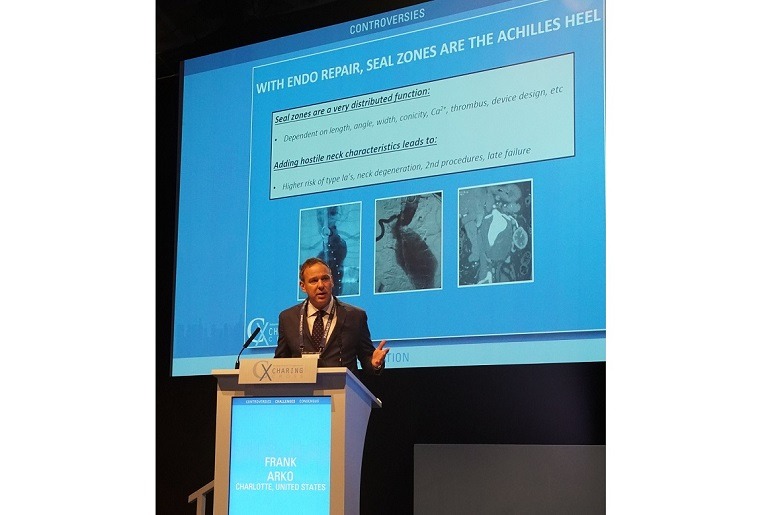
Frank Arko
Using EndoAnchors to fix and seal endovascular aortic grafts is safe and effective for short-neck abdominal aortic aneurysm (AAA) patients, two-year data from the ANCHOR global registry have shown. Frank Arko (Charlotte, USA) presented the findings yesterday at CX Symposium in a podium first session, confirming a high success rate for the procedure. “The goal of contemporary AAA therapy is the long-term durability of the repair. Surgical repair does this very well. Can we simulate and get those same results with endovascular repair, with the addition of EndoAnchors? I tend to think so, and I think that today would also suggest that as well.”
The ANCHOR registry is a prospective multicentre study in the USA and Europe. Of 584 patients in the primary arm, 100 had short neck indications at <10mm, and 70 were evaluated for one-year outcomes. Yesterday, two-year outcomes on the first 38 of these patients were made available. Arko explained: “The ANCHOR registry has now evolved into only evaluating these short necks. You have to have a neck diameter somewhere between 19 and 32mm, with angulation less than 60. It is truly an off-the-shelf approach, femoral only. The maximum size that you have to put in is the size of the Endurant [Medtronic], which is 20Fr. The EndoAnchors are actually placed within a 16Fr sheath.”
In all, 73% of subjects were male and mean age was 71.3 years. Arko said: “They were a sick group of patients; 93% were ASA Class III or IV; 17% presented symptomatically, so they had an increased risk of morbidity and mortality, and 31% were either urgent or emergent cases, requiring an off-the-shelf solution for management. It is a relatively aggressive or hostile anatomy—average neck length was <7mm, aneurysm size 5.8cm, angulation at 20.6 degrees and the diameter of the neck was borderline, some people would say, at 26mm in diameter.”
At the time of the original implant, the average duration of the procedure was 148 minutes, average time to implant EndoAnchors was 17 minutes, and average fluoroscopy time was 35 minutes. The average number of EndoAnchors implanted was 5.5.
Procedural success rate was 97.1%, with a 2% risk of type 1a endoleak at one year. “But,” Arko pointed out, “when you followed those patients up to two years, the risk of type 1a endoleak in these very hostile neck anatomies was 0%, and the risk of migration was 0%. And most people would consider the size of the aneurysm at long-term follow-up to be a true marker of complete exclusion of the aneurysm, with more and more data to suggest that regression of the aneurysm sac is probably the most important data that we look at.”
At one year, nearly half of the patients had regressed (44%), with 56% remaining stable. At two years, sac regression increased to 65%, and 35% remained stable, with no aneurysms increasing in size. Two-year freedom from all-cause mortality was 86.7%, and freedom from anerusym-related mortality was the same at one- and two-year follow-up, at 94.3%, with 96% freedom from secondary endovascular procedures and 100% freedom from aneurysm rupture.
Arko concluded: “At two-years’ follow-up, we have excellent clinical outcomes from a complex, short neck cohort, with no type Ia endoleaks, 65% sac regression, and only one proximal neck-related secondary procedure through two years.” He added: “It should be added to the armamentarium of any vascular surgeon treating this type of patient’s condition. There probably needs to be in this hostile neck anatomy a variety of different therapies offered to the patient.”
In a vote at the end of the session on whether physicians would support the use of EndoAnchors as a primary intention for short proximal necks based on the data, 54% said “yes” and 46% said “no”.







